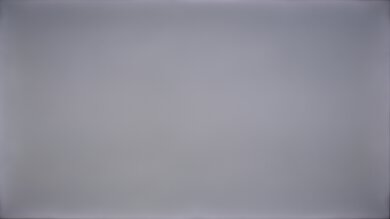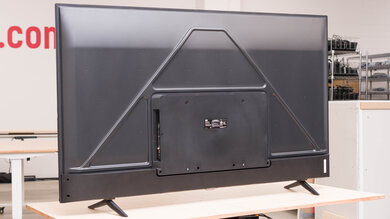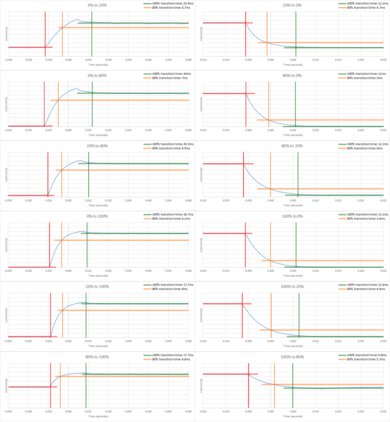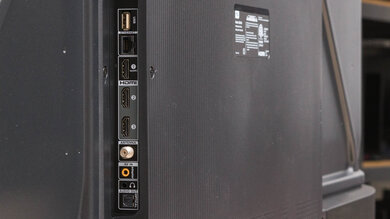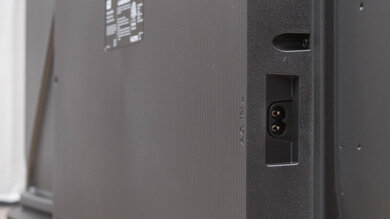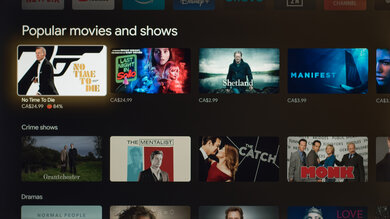The TCL 4 Series/S446 2021 is an entry-level 4k TV. It's a basic TV in TCL's 4 Series lineup that includes the TCL 4 Series/S435 2020 and the TCL 4 Series/S434 Android 2020. It's different from the other two 4 Series TVs because it uses the Google TV smart interface, while the S434 uses a similar Android TV interface, and the 4 Series 2020 has Roku. It competes with other entry-level TVs like the Hisense A6G, Toshiba C350 Fire TV 2021, and the Amazon Fire TV 4-Series.
Our Verdict
The TCL 4 Series is okay overall. It's best for watching sports or TV shows during the day in a moderately-lit room. It has a wide viewing angle that makes it a good choice for a wide seating arrangement, as you can move around and still enjoy a consistent image. It's alright for gaming because it has low input lag, but its response time is on the slow side, and it lacks extra gaming features. Unfortunately, it's disappointing for watching movies in a dark room because it has a low contrast ratio and lacks local dimming, so dark scenes don't look very good.
- No issues upscaling lower-resolution content.
- Image remains consistent when viewed from the sides.
- Good reflection handling.
- Low contrast ratio, so blacks look gray and washed out.
- Low peak brightness.
- Distracting motion blur behind fast-moving objects.
The TCL 4 Series is disappointing for watching movies in dark rooms. It has a low contrast ratio and bad black uniformity, and because there's no local dimming feature, dark scenes don't look very good and blacks look washed out. On the other hand, it upscales lower-resolution movies well, and it can remove judder from most sources, so movies are played back smoothly. There's also very little stutter in slow panning shots thanks to its relatively slow response time.
- No issues upscaling lower-resolution content.
- Removes judder from 24p sources and native apps.
- Low contrast ratio, so blacks look gray and washed out.
- No local dimming feature.
- Bad black uniformity.
The TCL 4 Series is good for watching TV shows in bright environments. It performs well in rooms with a few lights around because it has good reflection handling, but it doesn't get bright enough to fight a ton of glare. It upscales older shows on DVD well, with no noticeable issues, and the smart interface has a huge selection of streaming channels available, so you can easily find your favorite shows. Finally, it has a wide viewing angle, so the image remains consistent if you have a wide seating arrangement or like to move around with the TV on.
- No issues upscaling lower-resolution content.
- Image remains consistent when viewed from the sides.
- Good reflection handling.
- Low peak brightness.
- Disappointing built-in speakers.
The TCL 4 Series is decent for watching sports. It has a wide viewing angle, making it a good choice for watching the game with a few friends as the image remains consistent from the sides, so you don't have to fight over the best spot. It has good reflection handling if you want to use it in a room with a few lights, but its peak brightness is disappointing, so glare is still distracting if you have a lot of windows. Also, fast-moving content looks a bit blurry because of the only decent response time.
- No issues upscaling lower-resolution content.
- Image remains consistent when viewed from the sides.
- Good reflection handling.
- Low peak brightness.
- Disappointing built-in speakers.
- Distracting motion blur behind fast-moving objects.
The TCL 4 Series is okay for casual gamers. It has very low input lag, ensuring a responsive gaming experience with very little delay between your actions and what you see on the screen. Unfortunately, it has a slow response time, so there's more significant blur and ghosting behind fast-moving objects. It's also limited to a 60Hz fixed refresh rate, with no variable refresh rate support, so it's not ideal for the PS5 or Xbox Series X.
- Good reflection handling.
- Low input lag.
- Low contrast ratio, so blacks look gray and washed out.
- Distracting motion blur behind fast-moving objects.
- No extra gaming features like HDMI 2.1 bandwidth or variable refresh rate support.
The TCL 4 Series is disappointing for watching HDR movies. It only supports HDR10 and not Dolby Vision or HDR10+, and it can't display a wide color gamut. Also, it doesn't get bright enough to make highlights pop. It has a low contrast that makes blacks look gray and washed out, and it lacks a local dimming feature to improve the dynamic range. Overall, HDR looks dull and muted, and adds very little over SDR.
- Removes judder from 24p sources and native apps.
- Low contrast ratio, so blacks look gray and washed out.
- No local dimming feature.
- Low peak brightness.
- Can't display a wide color gamut.
The TCL 4 Series is alright for HDR gaming. It has low input lag for a responsive gaming experience, but it doesn't have any extra features like HDMI 2.1 bandwidth or variable refresh rate support. Also, it doesn't offer a good HDR experience because it has a low contrast ratio, poor HDR peak brightness, and it can't display a wide color gamut, so highlights and colors don't stand out at all.
- Low input lag.
- Low contrast ratio, so blacks look gray and washed out.
- Distracting motion blur behind fast-moving objects.
- No extra gaming features like HDMI 2.1 bandwidth or variable refresh rate support.
The TCL 4 Series is great to use as a PC monitor. Your mouse movements feel responsive thanks to the low input lag, but you may notice some motion blur due to the slow response time. It has a wide viewing angle, so the sides of the screen remain uniform even if you're sitting up close. Finally, it displays chroma 4:4:4 properly, which is essential for clear text from a PC.
- Image remains consistent when viewed from the sides.
- Good reflection handling.
- Low input lag.
- Low peak brightness.
- Distracting motion blur behind fast-moving objects.
Changelog
- Updated Sep 26, 2025: We uploaded the latest brightness measurements and uniformity photos for the Accelerated Longevity Test.
- Updated Jul 08, 2025: We uploaded the latest brightness measurements and uniformity photos for the Accelerated Longevity Test.
- Updated Apr 17, 2025: We uploaded the latest brightness measurements and uniformity photos for the Accelerated Longevity Test.
- Updated Feb 11, 2025: We uploaded the latest brightness measurements and uniformity photos for the Accelerated Longevity Test.
Check Price
Differences Between Sizes And Variants
We bought and tested the 65-inch TCL 4 Series, and it's also available in 43, 50, 55, 75, and 85-inch sizes. The 65-inch version has an IPS panel, but some of the other sizes use VA panels, which offer better contrast and deeper blacks, but a worse viewing angle.
| Size | US Model | Panel Type | VESA Mount | Notes |
|---|---|---|---|---|
| 43" | 43S446 | IPS | 200x200 | |
| 50" | 50S446 | VA | 200x300 | |
| 55" | 55S446 | IPS | 300x300 | |
| 65" | 65S446 | IPS | 300x300 | |
| 75" | 75S446 | IPS | 300x300 | |
| 85" | 85S446 | VA | 600x400 | Different stand configuration |
Our unit was manufactured in September 2021, and you can see the label here.
Popular TV Comparisons
The TCL 4 Series TV is a basic entry-level TV that doesn't deliver good picture quality, as it has a low contrast ratio and it lacks local dimming. However, for a cheap option, it has a few more features than similarly-priced TVs, like motion interpolation, backlight strobing, and judder-removal.
Also see our recommendation for the best TVs under $500, the best smart TVs, and the best budget TVs.
The TCL 4 Series/S435 2020 and the TCL 4 Series/S446 2021 are both part of the same lineup from TCL, but they have different features. The 4 Series 2020 uses Roku TV and has a VA panel with high contrast, while the 4 Series 2021 we tested has an IPS-like panel with wide viewing angles, but there are variants with a VA panel instead, and it has Google TV. The 4 Series 2021 is a better choice for bright rooms because it gets bright and has better reflection handling, and it has a quicker response time. The 4 Series 2021 also has a motion interpolation feature, which the 4 Series 2020 doesn't have, and it has lower input lag for a more responsive gaming experience.
The differences are minor, but overall, the TCL 4 Series/S446 2021 is a bit better than the Insignia F30 Series 2022. The TCL gets significantly brighter and it has slightly better reflection handling, so it can overcome more glare in a bright room. The TCL also has a faster response time for clearer motion when gaming, and it's better for use as a PC monitor as it can display chroma 4:4:4 properly, which is essential for clear text from a PC.
The Amazon Fire TV 4-Series and the TCL 4 Series/S446 2021 are basic entry-level TVs, and the models we tested have different panel types with strengths and weaknesses. The Amazon TV has a VA panel, which has a higher contrast, while the TCL we tested has an IPS-like panel with wider viewing angles, but there are variants of the TCL with a VA panel instead. The TCL has much better accuracy out-of-the-box. The TCL also upscales 480p content better because it doesn't crop the image, and it displays 4k content without issues. Both TVs remove 24p judder from native sources and apps, but the Amazon TV also removes it from 60p/i sources, which is great.
The Hisense A6G and the TCL 4 Series/S446 2021 are both okay entry-level TVs. The 65-inch models we tested both have IPS-type panels, but each TV is available in a variety of sizes, and some have VA panels instead. Picture quality is similar between each, except the reflection handling is better on the TCL. The TCL also has motion interpolation and backlight strobing features, both of which the Hisense doesn't have. The Hisense uses Android TV while the TCL has Google TV, and while they're essentially the same interface, Google TV is an upgraded version, so apps and settings open more quickly.

We buy and test dozens of TVs yearly, taking an objective, data-driven approach to deliver results you can trust. Our testing process is complex, with hundreds of individual tests that take over a week to complete. Most of our tests are done with specially designed test patterns that mimic real content, but we also use the same sources you have at home to ensure our results match the real-world experience. We use two main tools for our testing: a Colorimetry Research CR-100 colorimeter and a CR-250 spectroradiometer.
Test Results

After two months on our accelerated longevity test, this TV doesn't show any signs of degradation.
The stand is basic and doesn't support the screen all that well because there's wobble from front to back. It raises the screen enough to place a soundbar in front without blocking the screen. The 85-inch version has a different stand, with two T-shaped feet at the very end of the TV, similar to the one on the TCL R745 QLED.
Footprint of the 65 inch TV: 43.5" x 12.6" x 2" to the bottom bezel (three-inches from the table to the bottom of the screen). It's tall enough that most soundbars won't block your screen.
The TCL 4 Series has a metal back panel, with plastic at the bottom section, and where the inputs are. Sadly, there's no cable management. The inputs face to the side, but they're difficult to access as they're in the middle of the TV.
The build quality is okay. Most of the TV is made of plastic, but the back panel is made of cheap metal and it flexes easily, although this isn't likely to cause any issues. The plastic in the back and on the borders also feel flimsy, and the TV wobbles noticeably from front to back. Overall, it's although there are no significant issues noticeable with it, it feels pretty cheap.
The SDR peak brightness is disappointing. It doesn't get bright enough to fight glare in well-lit rooms, but it's consistent between different scenes as there's no frame dimming.
These measurements are after calibration with the following settings:
- Picture Mode: Movie
- Backlight: Max
- Contrast: Max
- Gamma: 2.2
- Color Temperature: Warm -5
The TCL 4 Series doesn't have a local dimming feature. The videos are still filmed so you can see how the backlight performs versus another TV.
Once again, there's no local dimming feature. The videos are still filmed so you can see how the backlight performs versus another TV.
The HDR brightness is poor, as it doesn't get bright enough to make highlights pop. The EOTF doesn't follow the target PQ curve well either, as most scenes are darker than they should be. Near-blacks are raised a bit, so shadow details are maintained but dark scenes look blown out overall.
These measurements are after calibrating the HDR white point with the following settings:
- Picture Mode: Movie
- Backlight: Max
- Contrast: Max
- Color Temperature: Warm -5
The HDR brightness is the same in Game Mode as outside of it. The image looks the same.
These measurements are with the following settings:
- Picture Mode: Game
- Backlight: Max
- Contrast: Max
- Color Temperature: Warm -5
The TCL 4 Series has okay gray uniformity. The sides of the screen are significantly darker than the center, which is noticeable in any content. There's also some dirty screen effect in the center, which is distracting when watching sports or displaying anything with a large area of uniform colors. Near-black scenes are a lot more uniform, with no significant issues.
Unfortunately, this TV has bad black uniformity. The entire screen looks blue and washed out due to the low contrast ratio. There's a significant amount of backlight bleed, especially towards the bottom right corner, and there's no local dimming feature to improve it.
The TCL 4 Series has a wide viewing angle, so the image remains consistent when viewing from the sides. It's a good choice for wide seating arrangements or if you like to move around with the TV on, as you'll see more or less the same image from anywhere.
The accuracy before calibration is incredible. There are minimal inaccuracies to the white balance and colors. Gamma is great overall, but really dark and really bright scenes are too bright, while others are a bit too dark. The color temperature is on the cold side, but it's still good.
The accuracy after calibration is remarkable. We didn't have to adjust the colors at all, and the white balance is slightly better. Both the gamma and the color temperature improved a bit, but not by much because we couldn't calibrate it too aggressively.
You can see our full calibration settings here.
The TCL 4 Series looks similar to the TCL 4 Series/S434 Android 2020 with the way it upscales 1080p content, which is fantastic.
The 65 inch model has an ADS panel, which is a type of IPS, similar to the Sony X80J. Unlike most other TVs, it uses an RGB subpixel layout, which helps deliver clear text from a PC.
The TCL 4 Series can't display a wide color gamut for HDR content. It has disappointing coverage of the Rec. 2020 color space, and while it has better coverage of the DCI-P3 color space used in most HDR content. However, it's still not as good as higher-end TVs.
The gradient handling is just decent. There's noticeable banding with most colors, especially darker shades, noticeable in scenes with shades of similar colors, like in a sunset. Setting the Gradation Clear setting to 'Low' or 'High' does a decent job at reducing the banding with the test pattern and in real content, but it also causes the loss of fine details in high-quality content.
Although some IPS-type panels can suffer from temporary image retention, this doesn't appear to be permanent as seen in our long-term test.
The TCL 4 Series has a decent response time, but there's overshoot in most transitions that leads to motion artifacts like inverse ghosting. You'll generally see this as a white trail behind fast-moving objects in shadows or darker areas of scenes.
The TCL 4 Series uses pulse width modulation (PWM) to dim its backlight at low brightness levels. Nearly all picture modes flicker at 150Hz if you set the Brightness to anything above '28', but the 'Low Power' mode starts flickering at '37', and 'Smart HDR' doesn't flicker at all. However, we don't expect this to be an issue for most people because setting it to '28' with most picture modes results in such a dim image.
There's a backlight strobing feature, commonly known as black frame insertion, to improve the appearance of motion. It flickers at 60Hz, and it reduces motion blur trail behind fast-moving objects. Keep in mind that the BFI score is based on the flicker frequency, and not the actual performance.
There's a motion interpolation feature to try to improve the appearance of motion when watching low frame rate content like most shows and movies. It looks similar to the TCL 5 Series/S546 2021 QLED, as it handles slow scenes well, but there more artifacts like halos when there are fast-moving objects on the screen.
Due to the slower response time, low-frame-rate content doesn't stutter much.
The TCL 4 Series removes judder from native apps and 24p sources, which helps with the appearance of motion in movies.
This TV doesn't support any variable refresh rate technology. If you're looking for a similar TV with VRR support, check out the Hisense A6H instead.
The TCL 4 Series has low input lag in Game Mode. It increases with a 4k or 1440p resolution compared to 1080p, but it's a minor difference that most people won't even notice.
This TV support most common resolutions up to 4k @ 60Hz, including 1440p @ 60Hz if you create a custom resolution from your PC. It also displays chroma 4:4:4 signals properly with 1080p and 4k signals at 60Hz, which is essential for clear text from a PC, but text looks blurry with 1440p signals.
Since this is a basic 60Hz TV, it doesn't support high frame rate signals from the PS5 or Xbox Series X. However, you can still play 4k games up to 60 fps in HDR10 from either console, and there's an Auto Low Latency Mode that automatically switches the TV into Game Mode when you launch a game from a compatible device.
The TCL 4 Series has eARC support, and it can pass Dolby Atmos signals to a compatible receiver through a single HDMI connection.
The frequency response is disappointing. It doesn't get loud, and there's no bass, if at all. Its sound profile isn't that well-balanced either, and it's fine for listening to dialogue, but you'll want to get a soundbar or receiver for the best sound experience.
The distortion handling is decent. There isn't too much distortion unless you're listening to content at its max volume, in which case, there's more. However, this depends on the content, and not everyone may hear it.
The TCL 4 Series uses Google TV, which is essentially an upgraded version of the Android TV used on the TCL 4 Series/S434 Android 2020, but with a few aesthetic differences. It's fast and easy to use, and the Play Store offers one of the widest selections of streaming apps.
This TV comes with the same remote as the TCL 5 Series/S546 2021 QLED. It's a straightforward remote with the necessary buttons to navigate the interface, and there are shortcut buttons to popular streaming services. It has a built-in mic for voice control, and you can ask it to change inputs, search for content, or open apps, but you can't ask it to change settings like the brightness.


